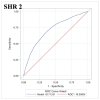Comparison of stress hyperglycemia ratio and glycemic gap on acute ICH in-hospital outcomes
- PMID: 38590111
- PMCID: PMC11187964
- DOI: 10.1002/acn3.52063
Comparison of stress hyperglycemia ratio and glycemic gap on acute ICH in-hospital outcomes
Abstract
Objective: To compare the effect of different indicators on stress-induced hyperglycemia for predicting in-hospital outcomes of acute intracerebral hemorrhage.
Methods: Using data from the Chinese Stroke Center Alliance database, which is a national, multicenter, prospective, and consecutive program. Stress-induced hyperglycemia was described as glycemic gap (GG, defined as fasting blood glucose [FBG] minus estimated average blood glucose) and stress hyperglycemia ratio (SHR, defined as FBG-to-estimated average blood glucose ratio [SHR 1] or FBG-to-HbA1c ratio [SHR 2]). The primary outcome was in-hospital mortality, and the second outcome was hematoma expansion.
Results: A total of 71,333 patients with acute intracerebral hemorrhage were included. In multivariate analyses, the highest levels of GG (OR 1.68, 95% CI 1.12-2.51), SHR 1 (OR 1.73, 95% CI 1.15-2.60), and SHR 2 (OR 2.07, 95% CI 1.33-3.23) were associated with in-hospital death (all the p trends <0.01). Only the highest level of SHR 2 (OR 1.24 [1.02-1.51], p trend >0.05) was related to hematoma expansion. No association between GG or SHR 1 and hematoma expansion was observed. The areas under the ROC curve of GG, SHR 1, and SHR 2 for in-hospital mortality were 0.8808 (95% CI 0.8603-0.9014), 0.8796 (95% CI 0.8589-0.9002), and 0.8806 (95% CI 0.8600-0.9012). The areas under the ROC curve of SHR 2 for hematoma expansion were 0.7133 (95% CI 0.6964-0.7302).
Interpretation: SHR (FBG-to-HbA1c ratio) was associated with both in-hospital death and hematoma expansion in intracerebral hemorrhage, and might serve as an accessory indicator for the in-hospital prognosis of intracerebral hemorrhage.
© 2024 The Authors. Annals of Clinical and Translational Neurology published by Wiley Periodicals LLC on behalf of American Neurological Association.
Conflict of interest statement
Jia Zhang, Qian Zhang, Hongqiu Gu, Qi Zhou, Zixiao Li, and Xingquan Zhao declare that they have no conflict of interest.
Figures



Similar articles
-
Glycemic Gap Predicts in-Hospital Mortality in Diabetic Patients with Intracerebral Hemorrhage.J Stroke Cerebrovasc Dis. 2021 May;30(5):105669. doi: 10.1016/j.jstrokecerebrovasdis.2021.105669. Epub 2021 Feb 23. J Stroke Cerebrovasc Dis. 2021. PMID: 33636475
-
Stress hyperglycemia indexes and early neurological deterioration in spontaneous intracerebral hemorrhage.Neurol Sci. 2025 Jul;46(7):3135-3145. doi: 10.1007/s10072-025-08097-8. Epub 2025 Mar 19. Neurol Sci. 2025. PMID: 40106104 Free PMC article.
-
Stress-Induced Hyperglycemia and Remote Diffusion-Weighted Imaging Lesions in Primary Intracerebral Hemorrhage.Neurocrit Care. 2020 Apr;32(2):427-436. doi: 10.1007/s12028-019-00747-y. Neurocrit Care. 2020. PMID: 31313140
-
Relationship between stress hyperglycaemic ratio (SHR) and critical illness: a systematic review.Cardiovasc Diabetol. 2025 May 2;24(1):188. doi: 10.1186/s12933-025-02751-3. Cardiovasc Diabetol. 2025. PMID: 40317019 Free PMC article.
-
Stress hyperglycemia and risk of adverse outcomes in patients with acute ischemic stroke: a systematic review and dose-response meta-analysis of cohort studies.Front Neurol. 2023 Nov 23;14:1219863. doi: 10.3389/fneur.2023.1219863. eCollection 2023. Front Neurol. 2023. PMID: 38073650 Free PMC article.
Cited by
-
Association between stress hyperglycemia ratio and postoperative major adverse cardiovascular and cerebrovascular events in noncardiac surgeries: a large perioperative cohort study.Cardiovasc Diabetol. 2024 Nov 2;23(1):392. doi: 10.1186/s12933-024-02467-w. Cardiovasc Diabetol. 2024. PMID: 39488717 Free PMC article.
-
Safety Study of Anticoagulants for Preventing Deep Venous Thrombosis after Intracerebral Hemorrhage: Data from the Chinese Stroke Center Alliance.Drugs Aging. 2025 Apr;42(4):329-337. doi: 10.1007/s40266-025-01187-4. Epub 2025 Feb 20. Drugs Aging. 2025. PMID: 39979772
-
Evaluation of novel glucose-related blood biomarkers for predicting in-hospital mortality in patients with acute ischemic stroke.PLoS One. 2025 May 21;20(5):e0324291. doi: 10.1371/journal.pone.0324291. eCollection 2025. PLoS One. 2025. PMID: 40397878 Free PMC article.
-
Stress Hyperglycemia as a Prognostic Indicator of the Clinical Outcomes in Patients with Stroke: A Comprehensive Literature Review.Biomedicines. 2025 Jul 28;13(8):1834. doi: 10.3390/biomedicines13081834. Biomedicines. 2025. PMID: 40868089 Free PMC article. Review.
-
Unveiling the role of stress hyperglycemia in predicting mortality for critically ill hemorrhagic stroke patients: insights from MIMIC-IV.Front Endocrinol (Lausanne). 2025 May 2;16:1558352. doi: 10.3389/fendo.2025.1558352. eCollection 2025. Front Endocrinol (Lausanne). 2025. PMID: 40385356 Free PMC article.
References
-
- Hemphill JC 3rd, Greenberg SM, Anderson CS, et al. Guidelines for the Management of Spontaneous Intracerebral Hemorrhage: a guideline for healthcare professionals from the American Heart Association/American Stroke Association. Stroke. 2015;46:2032‐2060. - PubMed
-
- Piironen K, Putaala J, Rosso C, Samson Y. Glucose and acute stroke: evidence for an interlude. Stroke. 2012;43:898‐902. - PubMed
-
- Capes SE, Hunt D, Malmberg K, Pathak P, Gerstein HC. Stress hyperglycemia and prognosis of stroke in nondiabetic and diabetic patients: a systematic overview. Stroke. 2001;32:2426‐2432. - PubMed
-
- Tziomalos K, Dimitriou P, Bouziana SD, et al. Stress hyperglycemia and acute ischemic stroke in‐hospital outcome. Metabolism. 2017;67:99‐105. - PubMed
Publication types
MeSH terms
Substances
Grants and funding
- Ministry of Finance of the People's Republic of China
- 2019-I2M-5-029/Chinese Academy of Medical Sciences Innovation Fund for Medical Sciences
- Z201100005620010/Beijing Municipal Committee of Science and Technology
- 202112/Beijing Hospitals Authority Innovation Studio of Young Staff Funding Support
- PX2020022/Beijing Municipal Administration of Hospitals Incubating Program
LinkOut - more resources
Full Text Sources
Medical
Miscellaneous
